Author: anderthalbAdmin
Issue 05 (2020)

For members only
ABSTRACTS
Film Forming Corrosion Inhibitor with Improved Handling, Feeding, and Corrosion Control Properties for Steam Generators
Mahesh Budhathoki, Donald Meskers Jr., Claudia Pierce, and Gregory Robinson
Film forming amine (FFA) products containing octadecylamine (ODA) or oleyl propylenediamine (OLDA) are known to provide excellent corrosion protection to the alloys used in the steam-water cycle of power plants. However, product formulations based on these filming amines exhibit poor water solubility, which often hinders successful application due to formulation stability, feeding, and handling. In this work, the water solubility of an OLDA-based FFA product is significantly improved with the addition of a co-surfactant and its efficacy as a corrosion inhibitor in steam generators is evaluated. Research boiler experiments indicate that the vapor-liquid distribution ratio of OLDA decreases by enhancing its water solubility. Also, the conductivity after cation exchange (CACE) measured in steam suggests that under normal boiler operation conditions, unlike neutralizing amines or co-solvents, the added co-surfactant does not contribute to the CACE in steam. Furthermore, electrochemical and corrosion testing indicates that the water-soluble FFA product can effectively inhibit corrosion, which is attributed to its ability to form a hydrophobic film on metal surfaces, as suggested by the contact angle measurements.
PPCHEM® 2020, 22(5), 182–194
For Members only
Testing the Suitability of the AMI CACE Monitor for the Water-Steam Cycle at Lippendorf Power Plant
Karla Georgi-Kruggel
In the period from January 06, 2020, to June 30, 2020, an analyzer for the automatic and continuous determination of conductivity before and after a cation exchanger with electro-deionization was tested at the Lippendorf Power Plant of Lausitz Energie Kraftwerke AG, Germany.
This report describes the setup and outcome of the trial. In summary, the proof of suitability of the analyzer for the monitoring of the water-steam cycle and the control of the conditioning agent quantities was positively demonstrated for all tested measuring points.
PPCHEM® 2020, 22(5), 196–202
For Members only
Comparative Study on the Ion Exchange Removal of Gadolinium Nitrate under the Conditions of the Moderator System of a Nuclear Reactor Using Styrene- and Acrylic- Acid-Based Macroporous Weak Base Anion Resins
A. L. Rufus, Padma S. Kumar, C. S. Sanjana, and S. Velmurugan
The fission reaction in a nuclear reactor is regulated by adding “neutron poison” to the system. Gadolinium has a high neutron absorption cross section and hence is used for this purpose in the form of aqueous solution of gadolinium nitrate. After its intended use, the neutron poison is removed from the system using mixed-bed (MB) ion exchange resin columns. A comparative study between the styrene- and acrylic-acid-based macroporous weak base anion (MWBA) resins in the MB column was carried out. Based on the parameters evaluated, which include (i) extent of utilization of the ion exchange capacity, (ii) precipitation of gadolinium in the ion exchange column, (iii) pressure drop across the column and (iv) radiation stability, the use of acrylic-acid-based resin in the MB ion exchange column was found to be good. The ion exchange capacity for acrylic-acid-based MWBA resin was higher (2.6 mEq ∙ mL–1 of resin as against 2.0 mEq ∙ mL–1 for styrene-based MWBA resin), 65 % utilization capacity as against 50 % for styrene-based MWBA resin, less precipitation of gadolinium (0.001 % as against 0.004 %), a favorable pressure drop and better retention of ion exchange capacity on irradiation.
PPCHEM® 2020, 22(5), 204–213
For Members only
Article – Issue 05 (2020) – Comparative Study on the Ion Exchange Removal of Gadolinium Nitrate under the Conditions of the Moderator System of a Nuclear Reactor Using Styrene- and Acrylic- Acid-Based Macroporous Weak Base Anion Resins
Article – Issue 05 (2020) – Testing the Suitability of the AMI CACE Monitor for the Water-Steam Cycle at Lippendorf Power Plant
Article – Issue 05 (2020) – Film Forming Corrosion Inhibitor with Improved Handling, Feeding, and Corrosion Control Properties for Steam Generators
Issue 04 (2020)

For members only
ABSTRACTS
Sampling Points and Parameters for Low-Pressure Industrial Steam Generators
Brad Buecker and Ken Kuruc
Although thousands of low-pressure steam generators exist at industrial plants around the globe, the chemistry of such units has not received the same attention as that of high-pressure units. The conditions in these steam generators are typically not as harsh as in utility units, yet water/steam chemistry control is still very important for the plants’ steam/condensate systems. This article discusses many of the most important sampling points and parameters for industrial steam generators, and it illustrates the benefits of proper chemistry control to maintaining equipment reliability and availability.
PPCHEM® 2020, 22(4), 142–150
For Members only
Modelling of Mechanical Oxygen Removal in a Power Plant Deaerator
Daniel Zinemanas
Oxygen removal is an integral part of the water/steam cycle chemical treatment in power plants and is generally performed in the deaerator. Understanding of this process, particularly during transient conditions, is important to analyze the plant data, and for this goal modelling of this process can be helpful. It is thus the main motivation of this paper to develop a simple workable theoretical model of the mechanical oxygen removal process in a power plant deaerator. Results of the model are compared to power plant operational data and show a very good match between the calculated and the measured data. Thus, the model can be useful in understanding the deaerator’s behavior and performance as well as for design or training.
PPCHEM® 2020, 22(4), 152–157
For Members only
A Practical View on the Dissolution of Air in Demineralized Water
Robert Svoboda
The equilibrium of the components of air with water can be calculated by means of Henry’s law and the ionization equilibria. This article gives guidance for such calculations and covers conditions up to 100 °C. At 25 °C and 1013mbar atmospheric pressure, the equilibrium for oxygen in water is 8.4 mg · kg–1. With 410 ppm CO2 in air, its mass fraction in water is 694 μg · kg–1 CO2, where 595 μg · kg–1 are present as dissolved gas and 99 μg · kg–1 are ionized to HCO3-. The result is a slightly acidic water with pH = 5.65 and 0.89 μS · cm–1 conductivity. In generator cooling water systems with neutral water treatment, this will cause an increase in copper release. With alkaline water treatment, the contact with untreated air can lead to the deterioration of alkaline conditions.
PPCHEM® 2020, 22(4), 160–169

